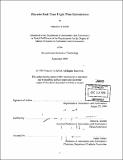Discrete real-time flight plan optimization
Author(s)
Le Sellier, Francois, 1974-
DownloadFull printable version (7.183Mb)
Other Contributors
Massachusetts Institute of Technology. Dept. of Aeronautics and Astronautics.
Advisor
James K. Kuchar.
Terms of use
Metadata
Show full item recordAbstract
Worldwide, the continuously growing air traffic induces a need for new ATM concepts to be defined. One possibility is using a more decentralized system predicated mainly around free routings (Free Flight), for a more flexible management of airspace. The present study first highlights the discrepancies and inefficiencies of the current best flightplan optimizing software that use the Cost Index concept before departure. It then investigates techniques to perform enhanced flight-plan optimizations en-route, with algorithms that are less complex than using the Cost Index. The long-haul flight leg that is considered through the simulations is London (UK) - Boston (MA, USA), flown on a constant flight level. This study shows that running another optimization at the Top of Climb point reduces the average delay at destination from 6.9 minutes to 5.0 minutes. Then, the more futuristic method of considering discrete flight-plan optimizations, while en-route using updated weather forecasts, provides results that are more interesting. If the weather forecasts and the optimizations are done simultaneously every 3-hour or 1.5-hour, the average delay respectively becomes 2.6 minutes or 2.0 minutes. The second part of this work investigates ways of performing a Linear Program to fly a route close to a 4D-trajectory. This study provides ways of determining the exact weight values for the different state variables used in the cost function to minimize.
Description
Thesis (S.M.)--Massachusetts Institute of Technology, Dept. of Aeronautics and Astronautics, 1999. Includes bibliographical references (leaves 117-118).
Date issued
1999Department
Massachusetts Institute of Technology. Department of Aeronautics and AstronauticsPublisher
Massachusetts Institute of Technology
Keywords
Aeronautics and Astronautics.